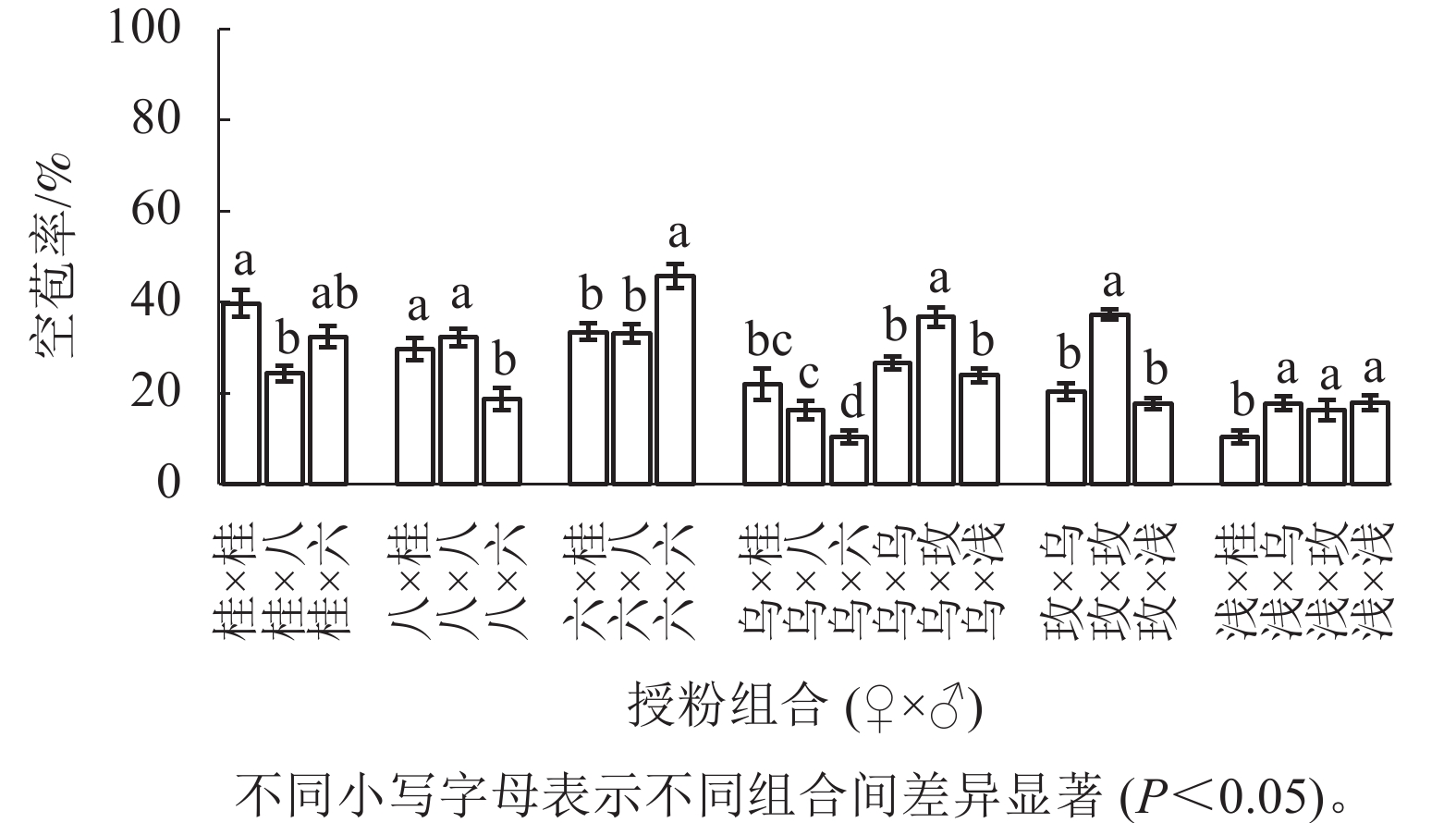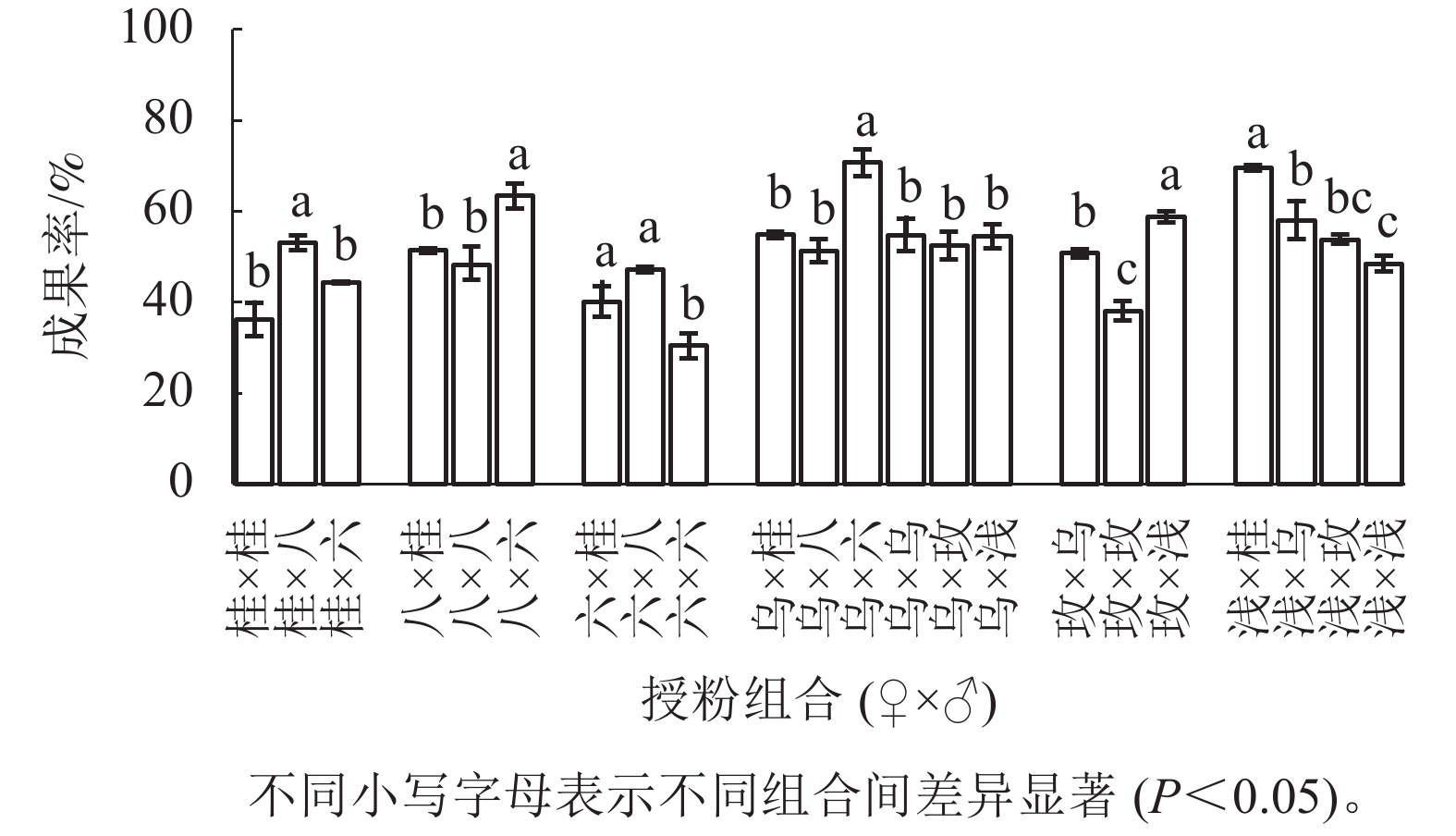-
板栗Castanea mollissima是著名的木本粮食和干果树种[1],果实风味独特,营养物质丰富[2−3],不与粮食作物争耕地,有“千果之王”和“铁杆庄稼”之誉[4]。板栗适应性强,是中国重要的经济林树种[5],中国板栗栽培总面积与产量稳居世界第一[6]。板栗花为风媒花,雌雄花同株[7],自花授粉结实率低,空苞率高[8−9],不同品种间授粉的亲和力也存在较大差异[10−11]。分别以河北迁西[12−13]、河北燕山[14]、广西隆安[15]、云南峨山和永仁[16]的板栗品种为试材,根据花期相遇情况,开展品种授粉配置试验,测定各组合的结实率和果实综合性状,筛选出了一批优良的授粉组合。湖北罗田县作为中国板栗的源生地,也是中国南方板栗主产区的中心[17−18],尚没有明确的品种授粉配置,单一品种种植和品种随意混植,严重影响了罗田县板栗良种的经济效益。因此,本研究以湖北省罗田县栽培的6个板栗品种为研究对象,根据品种间和品种内的花期相遇情况,选配授粉组合,开展授粉试验,对不同授粉组合的授粉结实性和果实性状进行测定分析,筛选高产优质的授粉组合,创新板栗良种的授粉配置栽培,以期为板栗良种的优质丰产栽培提供科学依据。
-
本研究在罗田县国家板栗良种基地进行。该基地位于湖北省罗田县骆驼坳镇赵家湾村,海拔150 m,年均气温为16.4 ℃,无霜期为240 d,日照时数为2 047 h,年降水量为1 230~1 600 mm。板栗林的株行距为5 m×5 m,树高4~7 m,树体健壮,长势良好,处于盛产期,进行常规管理。
-
共6个品种。其中,‘浅刺大板栗’‘Qiancidabanli’引自湖北省京山市,‘桂花香’‘Guihuaxiang’、‘八月红’‘Bayuehong’、‘六月暴’‘Liuyuebao’、‘乌壳栗’‘Wukeli’和‘玫瑰红’‘Meiguihong’为罗田县本地品种。分别用浅、桂、八、六、乌、玫代表这6个品种。
-
授粉组合见表1。根据品种间的雌、雄花花期相遇情况设计授粉组合,开展授粉试验,即选择授粉品种的雄花盛花期与被授粉品种的雌花盛花期相遇天数≥3 d的授粉组合,并设置品种内自交作为对照。授粉试验于2022年5月中下旬进行,采取人工授粉方式,进行品种内自交和品种间异交授粉。每个组合授粉150朵花,3次重复,每重复50朵。其中,品种间异交16个组合2 400朵花;品种内自交6个组合900朵花。共22个组合3 300朵花。
母本
(♀)父本(♂) 桂 八 六 乌 玫 浅 桂 √ √ √ − − − 八 √ √ √ − − − 六 √ √ √ − − − 乌 √ √ √ √ √ √ 玫 − − − √ √ √ 浅 √ − − √ √ √ 说明:√表示雌雄花盛花期相遇天数≥3 d,进行授粉实验;−表示雌雄花盛花期相遇天数<3 d,不进行授粉试验。 Table 1. Design of pollination combination
-
在雌花柱头分叉前,将雌花附近的雄花序去除干净,用硫酸纸袋套住雌花,金属丝扎紧套袋口,防止外来花粉干扰;收集新鲜花粉,在雌花柱头分叉为30°~45°时,去掉套袋,将充分干燥的花粉涂在雌花的柱头上,轻轻涂抹3~4次,之后立即套袋。待所有板栗品种的雄花落尽后,解除套袋。
-
2022年9月上中旬,板栗果实成熟时,采集所有刺苞,统计不同授粉组合的结实率、空苞率和成果率。计算公式如下:结实率=座苞数/授粉雌花数×100%;空苞率=无坚果刺苞数/座苞数×100%;成果率=有坚果刺苞数/授粉雌花数×100%。
-
①刺苞性状:每个授粉组合随机取30个实蓬的刺苞,用游标卡尺测定刺苞的横径、纵径和高度。用电子天平称量刺苞质量和每个刺苞内的坚果总质量,记录每个刺苞中的坚果个数。按以下公式计算出籽率:出籽率=每个刺苞内的坚果总质量/刺苞质量×100%。②坚果性状:每个授粉组合随机取30个坚果,用电子天平测定坚果质量和种仁质量。依据以下公式计算出仁率:出仁率=种仁质量/坚果质量×100%。③种仁营养物质:采用GB 5009.5—2016《食品安全国家标准 食品中蛋白质的测定》第一法测定蛋白质;采用GB 5009.6—2016《食品安全国家标准 食品中脂肪的测定》第一法测定脂肪;采用蒽酮比色法测定可溶性糖和淀粉。各组合每个指标3个重复。
-
应用 Excel 和 SPSS 进行数据统计分析。其中,百分数进行方差分析时,先进行反正弦转换;多重比较分析采用 Duncan 检验。
-
由图1可见:自交结实率较低,异交显著提高了结实率。以‘桂花香’为母本的3个组合结实率为60.40%~70.16%,其中,‘八月红’为父本授粉最高,自交最低,两者差异显著(P<0.05);以‘八月红’为母本的3个组合结实率为70.67%~78.02%,其中,‘六月暴’为父本授粉最高,自交最低,两者差异显著(P<0.05);以‘六月暴’为母本的3个组合的结实率为55.78%~70.62%,其中,‘八月红’为父本授粉最高,自交最低,两者差异显著(P<0.05);‘乌壳栗’为母本的6个组合的结实率为61.33%~82.26%,其中‘玫瑰红’授粉最高,‘八月红’授粉最低;‘玫瑰红’为母本的3个组合的结实率为60.70%~71.48%,‘浅刺大板栗’授粉最高,自交最低,两者差异显著(P<0.05),相差10.78%;‘浅刺大板栗’为母本的4个组合的结实率在58.03%~77.63%,‘桂花香’授粉最高,‘玫瑰红’授粉最低,两者差异显著(P<0.05),相差19.60%。
-
由图2可见:自交空苞率较高,除‘乌壳栗’外,各品种的自交空苞率均高于异交。‘桂花香’为母本的3个组合空苞率为24.33%~39.72%,‘八月红’授粉最低,自交最高;‘八月红’为母本的3个组合空苞率为18.71%~32.09%,‘六月暴’授粉显著降低了空苞率;‘六月暴’为母本的3个组合空苞率为33.11%~45.72%,异交显著降低了空苞率(P<0.05);‘乌壳栗’为母本的6个授粉组合空苞率为10.30%~36.71%,‘六月暴’授粉显著降低了空苞率(P<0.05);‘玫瑰红’为母本的3个授粉组合空苞率为17.73%~37.25%,异交显著降低了空苞率(P<0.05);‘浅刺大板栗’为母本的4个授粉组合空苞率为10.38%~18.00%,‘桂花香’授粉显著降低了空苞率(P<0.05)。
-
自交成果率较低,除‘乌壳栗’外,各品种的自交成果率均低于50.00%。异交显著提高了成果率(P<0.05)。各组合的成果率详见图3。‘桂花香’为母本的3个组合成果率为36.21%~53.09%,‘八月红’授粉显著提高了成果率(P<0.05);‘八月红’为母本的3个组合成果率为48.14%~63.48%,‘六月暴’授粉显著提高了成果率(P<0.05);‘六月暴’为母本的3个授粉组合成果率为30.42%~47.28%,异交显著提高了成果率(P<0.05);‘乌壳栗’为母本的6个授粉组合成果率为51.34%~70.76%,‘六月暴’授粉显著提高了成果率(P<0.05);‘玫瑰红’为母本的3个授粉组合成果率为38.11%~58.89%,‘浅刺大板栗’授粉的成果率最高,自交最低,两者差异显著(P<0.05),相差20.78%;‘浅刺大板栗’为母本的4个授粉组合成果率为48.54%~69.56%,‘桂花香’授粉显著提高了成果率(P<0.05)。
-
由表2可知:授粉品种对同母本的刺苞质量、刺苞横径、刺苞纵径、刺苞高、每刺苞坚果数、出籽率等性状具有显著影响(P<0.05)。‘桂花香’为母本时,异交显著提高了刺苞横径、每刺苞坚果数和出籽率(P<0.05),‘六月暴’授粉显著提高了刺苞质量(P<0.05);‘八月红’为母本时,‘桂花香’授粉的每刺苞坚果数显著大于自交,刺苞质量显著小于自交(P<0.05);‘六月暴’为母本时,自交的刺苞质量和每刺苞坚果数显著大于异交(P<0.05),‘八月红’授粉显著降低了出籽率(P<0.05);‘乌壳栗’为母本时,‘桂花香’授粉的每刺苞坚果数显著大于自交(P<0.05),‘六月暴’和‘玫瑰红’授粉的出籽率显著低于自交(P<0.05);‘玫瑰红’为母本时,异交显著提高了每刺苞坚果数和刺苞横径(P<0.05),‘乌壳栗’授粉的刺苞质量显著大于自交(P<0.05);‘浅刺大板栗’为母本时,‘玫瑰红’授粉的刺苞质量显著大于自交(P<0.05)。
母本(♀) 父本(♂) 质量/g 横径/mm 纵径/mm 高/mm 每刺苞坚果数 出籽率/% 桂 桂 44.03±1.79 b 68.71±1.24 c 61.23±0.95 b 57.64±0.70 a 1.17±0.07 c 31.84±0.40 c 八 47.67±1.40 b 75.68±0.72 b 63.65±1.22 b 54.26±0.65 b 2.37±0.03 a 43.44±0.46 a 六 59.72±0.98 a 79.34±0.58 a 67.89±0.76 a 59.54±0.32 a 1.93±0.03 b 36.48±1.80 b 八 桂 56.65±0.78 b 81.62±0.45 a 71.39±0.62 a 65.47±0.97 a 2.26±0.20 a 39.27±1.51 a 八 66.59±0.91 a 84.00±0.93 a 73.35±0.41 a 64.44±0.27 a 1.65±0.04 b 41.35±0.18 a 六 58.28±2.12 ab 81.78±1.03 a 71.05±1.40 a 65.90±1.37 a 2.18±0.16 ab 38.17±1.65 a 六 桂 73.32±2.60 b 92.63±1.35 ab 77.13±1.61 a 69.47±1.16 a 1.66±0.04 b 33.74±0.77 a 八 62.74±1.28 c 88.75±1.09 b 74.06±1.00 a 63.83±1.07 b 1.46±0.05 c 28.55±1.07 b 六 80.21±0.75 a 93.70±1.08 a 77.70±1.24 a 66.98±0.66 ab 1.91±0.04 a 35.73±1.51 a 乌 桂 70.66±0.93 a 85.53±0.47 a 70.84±0.36 a 62.32±0.67 a 2.82±0.04 a 37.61±0.69 abc 八 58.61±2.45 bc 78.13±1.13 c 68.25±1.43 a 60.23±0.73 ab 2.59±0.14 ab 41.70±0.77 a 六 61.00±4.99 abc 69.81±1.67 b 57.46±1.76 b 57.26±1.46 abc 2.16±0.04 c 33.72±0.17 c 乌 62.82±2.98 abc 81.4±2.39 ab 70.31±1.89 a 60.79±1.24 ab 2.33±0.13 bc 39.39±1.96 ab 玫 66.19±2.00 ab 70.59±1.46 c 58.16±2.52 b 55.34±1.82 bc 2.31±0.12 bc 34.85±1.70 c 浅 52.74±3.17 c 65.19±2.12 c 57.94±2.43 b 53.32±2.65 c 2.38±0.08 bc 36.46±1.39 bc 玫 乌 65.42±1.55 a 82.72±1.04 a 70.89±1.85 a 60.92±0.17 a 2.61±0.09 a 43.83±0.75 a 玫 56.21±1.77 b 79.12±0.20 b 66.37±0.73 a 60.15±0.77 a 2.27±0.12 b 44.85±0.36 a 浅 62.15±2.54 ab 83.99±0.97 a 70.79±0.92 a 61.49±0.53 a 2.60±0.10 a 44.51±0.33 a 浅 桂 54.56±2.29 ab 75.14±2.17 a 65.00±1.03 a 64.23±1.11 a 1.67±0.10 a 43.62±1.27 a 乌 59.96±2.86 ab 78.38±0.76 a 65.08±0.68 a 64.82±1.45 a 1.95±0.28 a 48.86±2.45 a 玫 62.29±2.77 a 76.85±0.32 a 63.81±1.04 a 62.16±0.75 a 2.06±0.06 a 51.10±3.19 a 浅 51.94±1.69 b 76.58±0.70 a 63.86±0.23 a 62.93±0.25 a 2.05±0.15 a 50.62±2.12 a 说明:数值为均值±标准误。不同小写字母表示不同组合间差异显著(P<0.05)。 Table 2. Main bracts characters of different pollination combinations
-
由表3可知:授粉品种对同母本的坚果质量、仁质量、出仁率具有显著影响(P<0.05)。‘桂花香’为母本时,‘八月红’授粉的仁质量显著小于自交(P<0.05),相差2.54 g;‘八月红’为母本时,‘桂花香’授粉显著减小了坚果质量和仁质量(P<0.05);‘六月暴’为母本时,‘八月红’授粉显著减小了坚果质量(P<0.05);‘乌壳栗’为母本时,‘六月暴’和‘玫瑰红’授粉的坚果质量显著大于‘浅刺大板栗’授粉,‘六月暴’授粉的仁质量显著大于‘浅刺大板栗’授粉(P<0.05),‘桂花香’和‘八月红’授粉的出仁率显著大于‘玫瑰红’授粉(P<0.05);‘玫瑰红’为母本时,‘乌壳栗’授粉的坚果质量显著大于‘浅刺大板栗’授粉,‘浅刺大板栗’授粉显著降低了仁质量和出仁率(P<0.05);‘浅刺大板栗’为母本时,‘乌壳栗’和‘玫瑰红’授粉的坚果质量显著大于自交,异交显著提高了仁质量(P<0.05)。
母本(♀) 父本(♂) 坚果质量/g 仁质量/g 出仁率/% 蛋白质质量
分数/%可溶性糖质量
分数/%淀粉质量
分数/%脂肪质量
分数/%桂 桂 11.71±0.19 a 9.82±0.22 a 83.67±0.67 a 6.52±0.02 ab 10.84±0.48 a 65.50±1.24 ab 2.18±0.07 a 八 9.58±0.88 a 7.28±0.16 b 81.00±1.16 a 6.60±0.18 a 12.53±0.49 a 64.32±0.45 b 2.33±0.07 a 六 9.87±0.67 a 8.91±0.42 a 81.69±0.15 a 6.12±0.12 b 10.69±0.68 a 69.57±1.52 a 2.17±0.15 a 八 桂 10.34±0.52 b 8.61±0.31 b 83.38±1.34 a 6.65±0.11 a 10.44±0.50 a 58.91±0.54 b 1.87±0.19 a 八 13.10±1.44 a 11.03±0.74 a 84.13±0.60 a 5.60±0.04 b 10.39±0.15 a 60.38±2.43 ab 2.23±0.20 a 六 12.65±0.71 a 10.80±021 a 85.41±1.38 a 6.56±0.08 a 10.24±0.21 a 67.24±2.17 a 2.17±0.13 a 六 桂 15.22±0.49 a 12.67±1.43 a 82.94±5.24 a 7.56±0.19 a 11.70±0.41 a 51.81±1.47 b 2.47±0.09 a 八 11.79±0.66 b 9.46±0.59 a 80.59±2.76 a 7.22±0.29 a 12.11±0.45 a 54.41±0.81 b 2.60±0.15 a 六 14.67±0.62 a 11.77±0.05 a 80.56±3.62 a 7.54±0.23 a 11.68±0.41 a 58.65±0.34 a 2.73±0.03 a 乌 桂 9.93±0.69 ab 7.87±0.62 ab 79.08±0.79 a 7.24±0.11 b 11.99±0.15 a 62.11±1.94 a 1.53±0.27 ab 八 10.77±0.31 ab 8.58±0.27 ab 79.63±0.16 a 7.34±0.04 b 12.33±0.72 a 62.23±3.75 a 1.60±0.31 ab 六 11.85±0.90 a 9.33±0.80 a 78.64±0.80 ab 6.49±0.17 c 8.67±0.14 b 55.36±0.24 a 1.43±0.03 ab 乌 10.39±0.19 ab 8.12±0.25 ab 78.13±1.00 ab 7.94±0.13 a 12.22±0.79 a 60.44±1.99 a 1.30±0.31 ab 玫 10.82±0.65 a 8.06±0.78 ab 74.20±2.21 b 6.08±0.03 d 7.87±0.13 b 56.61±0.51 a 1.27±0.03 b 浅 8.75±0.30 b 6.82±0.14 b 78.23±1.43 ab 6.81±0.19 d 8.38±0.13 b 59.63±1.06 a 2.07±0.03 a 玫 乌 10.80±0.07 a 8.59±0.03 a 79.57±0.28 a 8.13±0.11 c 9.85±0.38 a 64.55±2.13 a 1.33±0.17 a 玫 10.12±0.31 ab 8.11±0.29 a 80.17±0.69 a 8.84±0.17 b 10.63±0.62 a 61.36±1.11 ab 1.40±0.30 a 浅 9.57±0.18 b 7.36±0.18 b 76.81±0.46 b 10.43±0.09 a 10.78±0.39 a 58.20±1.21 b 1.03±0.28 a 浅 桂 12.40±0.50 ab 10.57±0.36 a 85.33±0.82 a 7.42±0.07 b 10.38±0.50 a 55.39±0.74 a 1.93±0.03 a 乌 12.88±0.29 a 10.25±0.51 a 79.47±2.86 a 7.85±0.05 a 10.25±0.16 a 55.01±1.62 a 2.07±0.03 a 玫 13.88±0.42 a 11.33±0.37 a 81.35±1.77 a 6.52±0.04 c 10.53±0.13 a 56.03±0.80 a 1.67±0.09 b 浅 10.59±0.77 b 8.70±0.22 b 82.84±2.13 a 7.56±0.09 b 10.24±0.29 a 52.25±1.26 a 1.94±0.06 a 说明:数值为均值±标准误。不同小写字母表示不同组合间差异显著(P<0.05)。 Table 3. Main nuts characters and nutrient contents in kernel of different pollination combinations
-
由表3可知:总体授粉品种对同母本组合的种仁淀粉和蛋白质质量分数的影响显著,对可溶性糖及脂肪质量分数的影响较小。‘桂花香’为母本时,‘八月红’授粉的蛋白质质量分数(6.60%)显著高于‘六月暴’授粉(6.12%)(P<0.05),淀粉质量分数(64.32%)显著低于‘六月暴’授粉(69.57%)(P<0.05);‘八月红’为母本时,异交显著提高了蛋白质质量分数(P<0.05),同时,‘六月暴’授粉的淀粉质量分数(67.24%)显著高于‘桂花香’授粉(58.91%)(P<0.05);‘六月暴’为母本时,自交的淀粉质量分数(58.65%)显著高于异交(51.81%、54.41%)(P<0.05);‘乌壳栗’为母本时,自交的蛋白质质量分数(7.94%)显著高于异交(P<0.05),淀粉质量分数差异不显著;‘玫瑰红’为母本时,‘浅刺大板栗’授粉显著提高了蛋白质质量分数(P<0.05),‘乌壳栗’授粉的淀粉质量分数(64.55%)显著高于‘浅刺大板栗’授粉(58.20%);‘浅刺大板栗’为母本时,‘八月红’授粉显著提升了蛋白质质量分数(P<0.05),‘六月暴’授粉显著降低了脂肪质量分数,但各组合的淀粉质量分数差异不显著。
-
由表4可知:按照特征根>1的原则,共提取到4个主成分,它们的累计贡献率为83.441%。其中,主成分1特征值为5.092,贡献率为39.167%,刺苞高、仁质量、坚果质量、刺苞横径和刺苞纵径的载荷较高;主成分2特征值为2.705,贡献率为20.809%,种仁蛋白质质量分数、单刺苞坚果数、刺苞横径和刺苞质量的载荷较高;主成分3特征值为1.658,贡献率为12.751%,种仁淀粉和可溶性糖质量分数的载荷较高;主成分4特征值为1.389,贡献率为10.688%,出籽率和出仁率的载荷较高。
性状 第1主成分 第2主成分 第3主成分 第4主成分 性状 第1主成分 第2主成分 第3主成分 第4主成分 刺苞质量 0.560 0.508 −0.308 −0.485 出仁率 0.532 −0.497 0.331 0.487 刺苞横径 0.797 0.547 0.166 −0.105 蛋白质质量分数 −0.052 0.768 −0.072 0.310 刺苞纵径 0.792 0.477 0.310 −0.069 可溶性糖质量分数 0.459 0.337 0.606 0.142 刺苞高度 0.889 0.219 −0.098 0.224 淀粉质量分数 −0.250 −0.070 0.774 −0.117 单刺苞坚果数 −0.534 0.683 0.052 −0.016 脂肪质量分数 0.637 −0.501 0.276 −0.105 出籽率 −0.161 0.258 −0.204 0.839 特征值 5.092 2.705 1.658 1.389 坚果质量 0.836 −0.211 −0.391 0.009 贡献率/% 39.167 20.809 12.751 10.688 仁质量 0.867 −0.298 −0.274 0.070 累计贡献率/% 39.167 59.975 72.726 83.414 Table 4. Component matrix of fruit characters
根据主成分1~4的得分(F1~F4)和各主成分权重,计算总得分(F),得出各授粉组合板栗果实的综合性状排名(表5)。由表5可知:同母本的授粉组合中,排名前 2 的组合(♀×♂)分别为:‘桂花香’ב六月暴’、‘桂花香’ב八月红’;‘八月红’ב八月红’、‘八月红’ב六月暴’; ‘六月暴’ב桂花香’、‘六月暴’ב六月暴’; ‘乌壳栗’ב桂花香’、‘乌壳栗’ב乌壳栗’;‘玫瑰红’ב浅刺大板栗’、‘玫瑰红’ב乌壳栗’;‘浅刺大板栗’ב乌壳栗’、‘浅刺大板栗’ב桂花香’。
授粉组合(♀×♂) F1 F2 F3 F4 F 排名 六×桂 5.16 0.30 −1.04 −0.58 2.27 1 六×六 4.54 0.99 −0.18 −1.36 2.18 2 六×八 2.44 −0.20 0.60 −1.54 0.99 3 八×八 2.52 −1.32 0.06 −0.08 0.85 4 八×六 1.61 −1.03 1.22 0.36 0.73 5 乌×桂 −0.38 2.38 1.02 −1.01 0.44 6 八×桂 0.32 −0.01 0.66 0.45 0.31 7 玫×浅 −1.61 3.85 −0.39 0.76 0.25 8 浅×乌 0.64 0.04 −1.60 1.29 0.24 9 乌×乌 −0.73 1.92 0.62 −0.29 0.19 10 浅×桂 0.91 −1.62 −0.71 1.70 0.14 11 玫×乌 −0.88 1.92 0.14 0.05 0.09 12 浅×玫 0.67 −0.63 −1.75 1.44 0.08 13 乌×八 −0.88 1.11 1.03 0.20 0.04 14 玫×玫 −1.47 1.30 0.23 1.06 −0.19 15 浅×浅 −0.58 −0.39 −0.90 2.32 −0.20 16 桂×六 −0.42 −1.08 2.03 −0.92 −0.28 17 桂×八 −2.08 −0.69 2.36 0.63 −0.71 18 桂×桂 −0.60 −3.66 1.37 0.06 -0.98 19 乌×六 −1.97 −1.31 −2.05 −1.23 −1.72 20 乌×玫 −3.16 −0.45 −2.39 −2.35 −2.26 21 乌×浅 −4.02 −1.42 −0.32 −0.97 −2.42 22 Table 5. Comprehensive principal component values
-
父本雄花盛花期与母本雌花盛花期相遇时间较长,能保证充分授粉和受精,是开展授粉配置研究的前提[18−19]。板栗树体高大,同一株树上,树冠上部的雌、雄花进入盛花期较早,树冠下部和内堂的雌、雄花进入盛花期较晚。在实际生产中,为了提高产量,应尽量使整株树的雌花都能够充分授粉,这就要求所选品种的花期相遇天数越多越好。本研究选择的22个授粉组合中,雌、雄花盛花期相遇天数均不少于3 d。
不同授粉组合对板栗的成果率及单个刺苞内的坚果数均有较大影响,表明授粉亲和性对板栗产量的影响较大,这与刘宁伟等[20]对板栗和张旭辉等[21]对锥栗C. henryi的研究结果一致。郭素娟等[22]认为:大部分板栗品种自花授粉亲和性差。在本研究中,多数自交组合不仅空苞率高,且成果率和每个刺苞中的坚果个数均显著低于异交组合。但也有自交授粉成果率较高,自交亲和性较好的品种,如‘乌壳栗’和‘浅刺大板栗’,其中,‘乌壳栗’自交所结果实的品质优良。可见,板栗自交授粉的亲和性也因品种而异。在油茶Camellia oleifera [23]、梨Pyrus[24]、文冠果Xanthoceras sorbifolium [25]、中国李Prunus salicina[26]品种的授粉研究中也发现了类似现象。
在本研究中,异花授粉显著提高了成果率和单刺苞内的坚果个数,可能原有的营养水平难以满足果实生长发育需要,导致‘六月暴’和‘八月红’异交组合的刺苞质量和体积显著小于自交组合。因此,在合理选配板栗品种授粉组合的同时,还需提高水肥供应,做好田间管理,促进板栗果实的生长和发育,提高板栗产量及果实的品质。
本研究发现这6个品种各有优劣。‘六月暴’各授粉组合的刺苞质量较大,为72.32~82.21 g,种仁蛋白质、糖类和脂肪丰富,果实品质综合排名靠前。从果实成熟时间来看,‘六月暴’为早熟品种,在8月下旬成熟,而罗田县大多数板栗品种成熟时间为9月上中旬,因此‘六月暴’可较早进入市场。但‘六月暴’成果率低,仅为30.42%~47.28%,表现出不丰产的特性。‘桂花香’风味独特,但其刺苞和坚果均较小,果实品质综合评分较低。
-
不同授粉处理对板栗的结实率、空苞率、成果率、刺苞性状、坚果性状和种仁营养物质质量分数均有不同程度的影响。综合成果率和果实品质,结合主成分分析,筛选出6个品种的成果率高、果实品质优良的授粉组合(♀×♂)各1~2个,分别为‘桂花香’ב八月红’、‘八月红’ב六月暴’、‘六月暴’ב桂花香’、‘六月暴’ב八月红’、‘乌壳栗’ב六月暴’、‘玫瑰红’ב浅刺大板栗’、‘浅刺大板栗’ב桂花香’、‘浅刺大板栗’ב乌壳栗’。在实际生产中,‘八月红’和‘六月暴’互相授粉表现均优秀,可以等比例栽植。其余组合正向授粉表现优秀,反向授粉表现一般,应以母本为主,少量栽植授粉树。由此可见,合理的品种授粉配置可以有效降低罗田板栗品种的果实空苞率,提高果实产量与品质,实现高产优质栽培。罗田县板栗品种资源丰富,本研究只研究了其中的6个品种,后续可以对其余品种进行相关研究,掌握开花物候期和适宜的授粉品种。
Pollination configuration of Castanea mollissima cultivars in Luotian County
doi: 10.11833/j.issn.2095-0756.20230437
- Received Date: 2023-08-25
- Accepted Date: 2024-03-04
- Rev Recd Date: 2024-01-16
- Available Online: 2024-05-22
- Publish Date: 2024-05-22
-
Key words:
- Castanea mollissima /
- pollination configuration /
- flowering period /
- final fruit rate /
- fruit characters /
- Luotian County
Abstract:
| Citation: | WEI Zhenyu, ZHANG Long, LI Aihua, et al. Pollination configuration of Castanea mollissima cultivars in Luotian County[J]. Journal of Zhejiang A&F University, 2024, 41(3): 606-614. DOI: 10.11833/j.issn.2095-0756.20230437 |




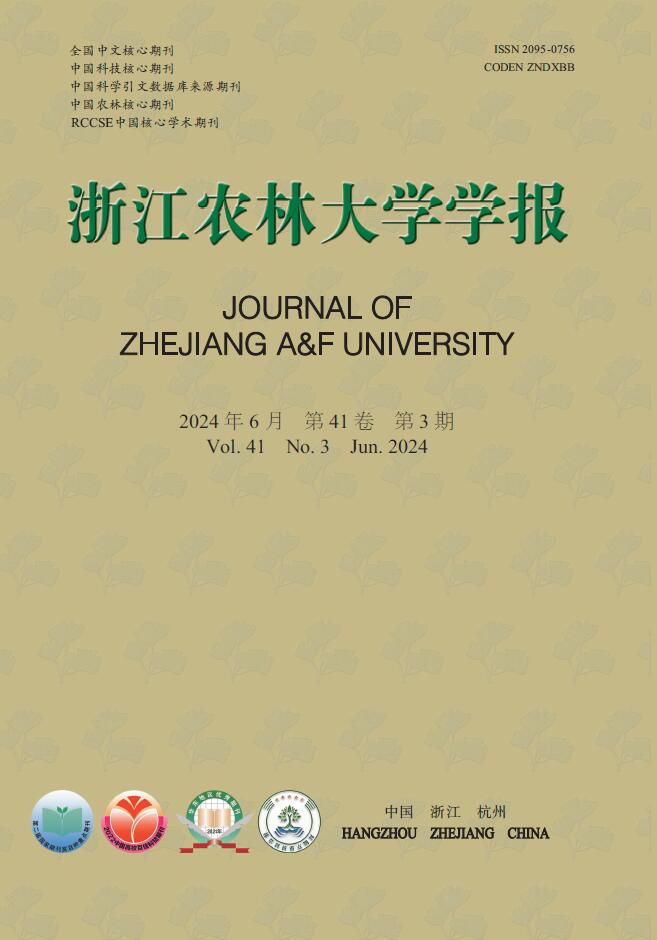


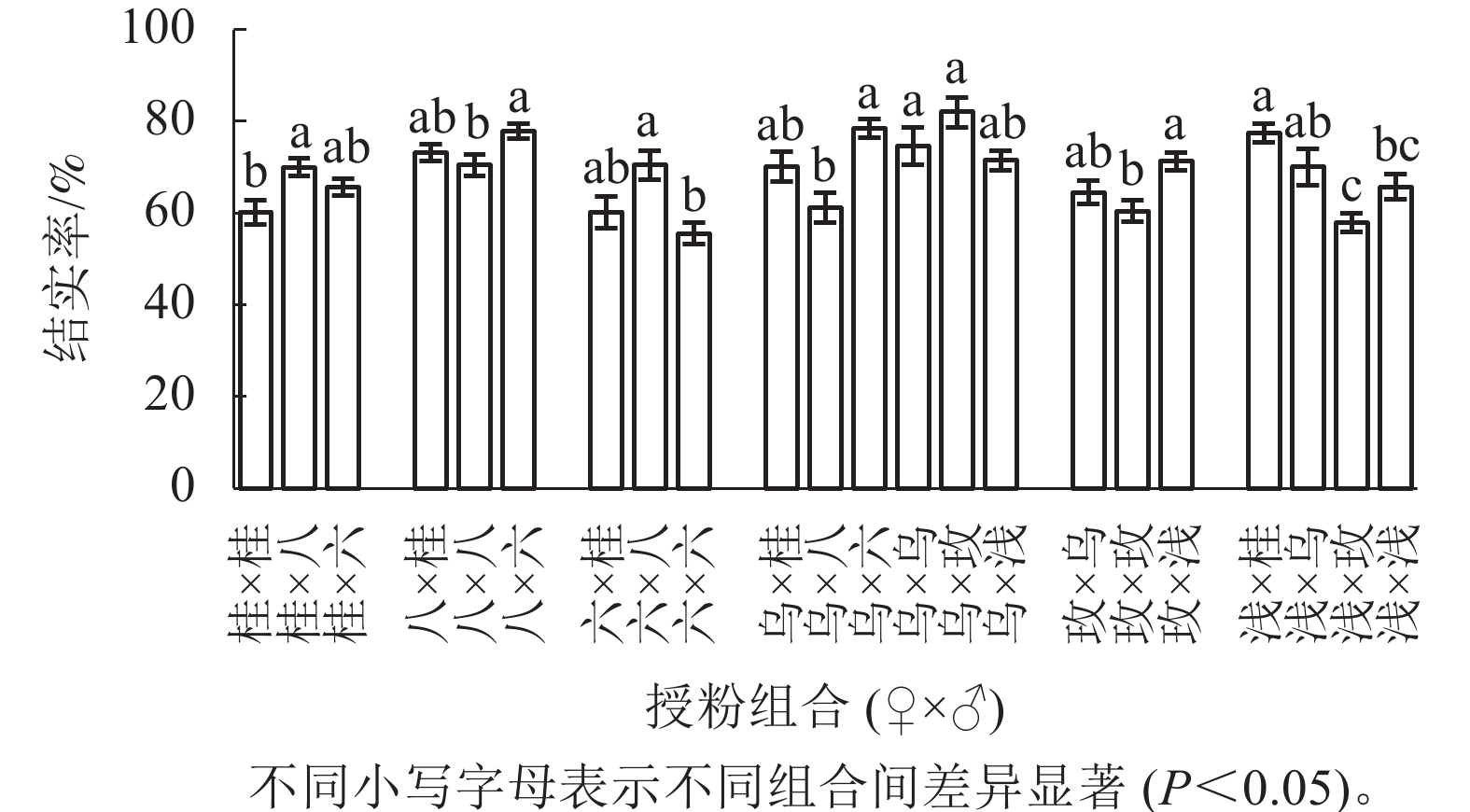


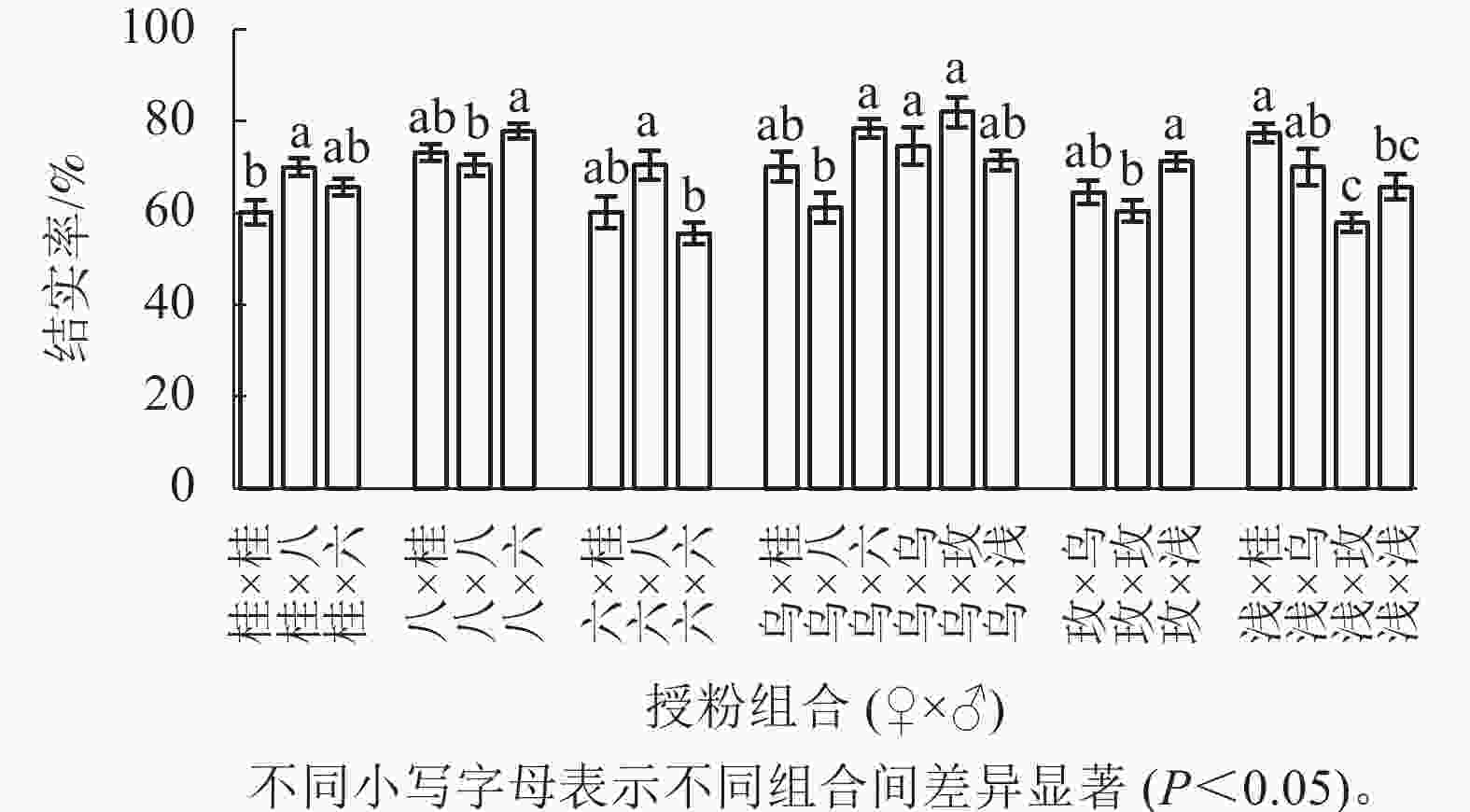


 DownLoad:
DownLoad:
